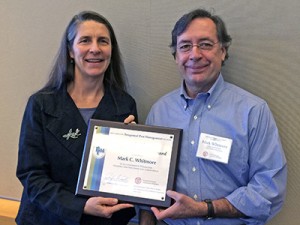
ITHACA, NY. November 3, 2015: Emerald ash borer. Hemlock woolly adelgid. These pests pack a one-two punch for New York’s 18 million acres of forestland. Now, for his hard work and dedication in slowing the spread of these formidable pests, Mark Whitmore — a forest entomologist at Cornell University — has received an Excellence in IPM award from the New York State Integrated Pest Management Program (NYS IPM) at Cornell University.
Indeed, Whitmore was the “Paul Revere” of sneaky invasive pests such as emerald ash borer and hemlock wooly adelgid long before they crossed the state line, says Brian Skinner, senior arborist with National Grid, an electric transmission distributor in New York and New England. Like other transmission companies, National Grid is deeply concerned by the potential damage that borer-killed ash trees could cause our electric system.
“Mark has been an avid and welcomed presenter to those of us in New York’s utility vegetation management industry,” Skinner says. “Often addressing small crowds with NIMBY attitudes, he offers a hope of preservation. He never gives up, becomes despondent or changes his message.”

Dr. Hilary Lambert, executive director of the Cayuga Lake Watershed Network and well aware of the value of hemlock trees to watershed health, couldn’t agree more. “Mark has been ready to help the public at every step of the way in developing outreach materials, volunteer events, and teams to monitor for the adelgid, not only in the Cayuga Lake basin but widely across the state.” Lambert says. “His emphasis on effective solutions, not despairing hand-wringing, has been especially welcome.”
Whitmore’s work is built around classic IPM techniques: prevention and monitoring, biological controls — the predators and parasites of these two pests — and, if needed, low-toxicity pesticides. “Mark’s meticulous research brings together all the strengths of IPM; of truly integrated pest management,” says Jennifer Grant, director of NYS IPM. But it’s his passion for his work that really makes the difference, Grant notes. “Whether it’s volunteer citizen-science groups, utility companies, or the New York State Department of Environmental Conservation, people look to Mark for the information and expertise they need,” Grant says. “He speaks for the trees.”
Whitmore received his award at on November 3 at Cornell University’s Ag In-Service training before dozens of his peers.